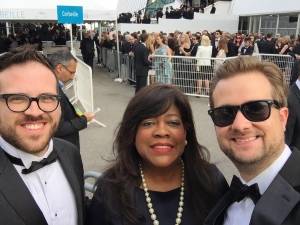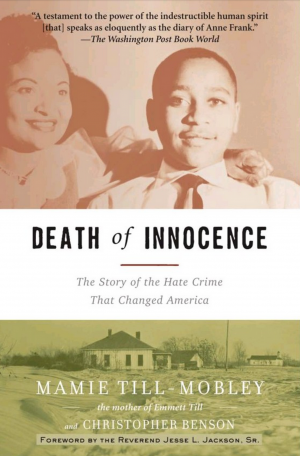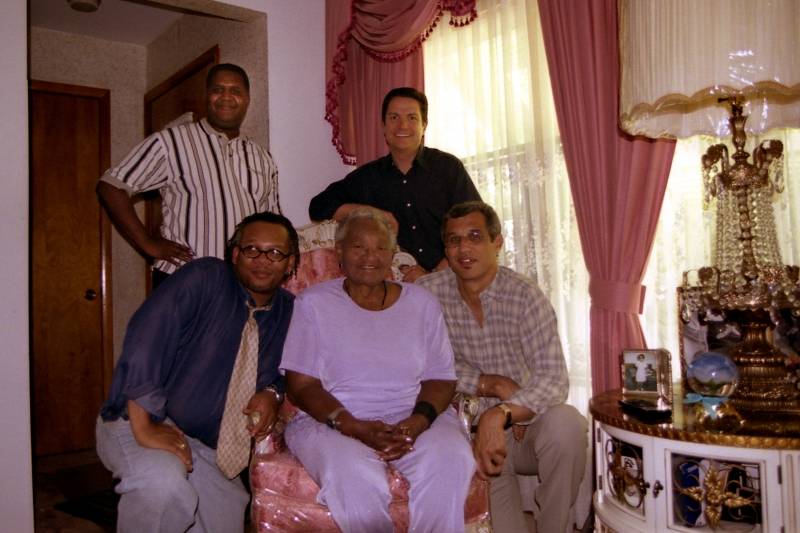 Every big idea needs a spark, a little extra nudge, to bring the hypothetical into the material world. Shatterglass Studios is all about that spark. Since its inception in 2005, the studio has grown into the premiere film production company of Champaign-Urbana, creating high-impact, professional films and commercial media. From feature films and documentaries to recruitment videos and commercials, Shatterglass does it all with top-notch quality and a genuine passion for storytelling. Now the studio is taking on one of its most passion-driven projects to date: Death of Innocence, a biopic on the death of Emmett Till, a 14-year-old African-American boy who was beaten to death in 1955 for flirting with a white woman, and the legacy he and his mother Mamie left on the civil rights movement. To get the scoop on the amazing history of Shatterglass and this particular feature, I had the privilege of interviewing Luke Boyce (pictured above), creative director of Shatterglass Studios and director at Shatterglass Films, and Brett Hays (below), president/project manager of Shatterglass Studios and producer at Shatterglass Films.
Every big idea needs a spark, a little extra nudge, to bring the hypothetical into the material world. Shatterglass Studios is all about that spark. Since its inception in 2005, the studio has grown into the premiere film production company of Champaign-Urbana, creating high-impact, professional films and commercial media. From feature films and documentaries to recruitment videos and commercials, Shatterglass does it all with top-notch quality and a genuine passion for storytelling. Now the studio is taking on one of its most passion-driven projects to date: Death of Innocence, a biopic on the death of Emmett Till, a 14-year-old African-American boy who was beaten to death in 1955 for flirting with a white woman, and the legacy he and his mother Mamie left on the civil rights movement. To get the scoop on the amazing history of Shatterglass and this particular feature, I had the privilege of interviewing Luke Boyce (pictured above), creative director of Shatterglass Studios and director at Shatterglass Films, and Brett Hays (below), president/project manager of Shatterglass Studios and producer at Shatterglass Films.
 The studio itself began with a kind of spark from both Boyce and Hays. Though neither had any major experience in the filmmaking business, they decided to form a company that would craft industry-level films while utilizing those skills in commercial filmmaking. Even facing an uncertain future, they remained positive. They soon found support from local entrepreneur Scott Reichard. “He had a desire to start a similar company at the time,” says Boyce. “He was someone who really believed in the transformative power of cinema and we became friends.” With their initial funds, Shatterglass invested in a RED Camera, equipment that was being developed by Oakley Sunglasses founder Jim Jannard. It was a controversial and risky move, since no one had seen the device or footage from it, but, taking a major chance, Shatterglass became one of the first 500 beta-testers of the camera in 2008. Their hunch turned out to be right, as RED has since become the leading digital camera in Hollywood, notably used by Peter Jackson to film all three Hobbit films.
The studio itself began with a kind of spark from both Boyce and Hays. Though neither had any major experience in the filmmaking business, they decided to form a company that would craft industry-level films while utilizing those skills in commercial filmmaking. Even facing an uncertain future, they remained positive. They soon found support from local entrepreneur Scott Reichard. “He had a desire to start a similar company at the time,” says Boyce. “He was someone who really believed in the transformative power of cinema and we became friends.” With their initial funds, Shatterglass invested in a RED Camera, equipment that was being developed by Oakley Sunglasses founder Jim Jannard. It was a controversial and risky move, since no one had seen the device or footage from it, but, taking a major chance, Shatterglass became one of the first 500 beta-testers of the camera in 2008. Their hunch turned out to be right, as RED has since become the leading digital camera in Hollywood, notably used by Peter Jackson to film all three Hobbit films.
Though they had the latest equipment and the financial backing, Shatterglass still needed an extra boost. With Boyce living in Champaign and Hays in Springfield, running the company from two different cities proved a difficult task. It wouldn’t be until 2010, when Hays re-located to the Champaign area, that things really took off for Shatterglass. They began filming media for local businesses and organizations that could barely afford advertising, turning out professional work for little to no charge. They created promotional videos for causes they cared about both at home  and abroad, even as far away as Honduras. These earlier pieces, shot with the RED camera, would help Shatterglass gain tremendous support. “It was incredible,” Hays explains, “how quickly we went from just working really hard and not getting anywhere to working really hard and making tons of amazing connections.” One such connection was the late Roger Ebert and his wife, Chaz, who is currently acting as executive producer on Death of Innocence.
and abroad, even as far away as Honduras. These earlier pieces, shot with the RED camera, would help Shatterglass gain tremendous support. “It was incredible,” Hays explains, “how quickly we went from just working really hard and not getting anywhere to working really hard and making tons of amazing connections.” One such connection was the late Roger Ebert and his wife, Chaz, who is currently acting as executive producer on Death of Innocence.
The studio’s outstanding work earned the Champaign County Chamber of Commerce Small Business of the Year Award in 2012, along with two Mid-America Emmys and four Telly Awards. This was incredible recognition, although while Shatterglass Studios had been creating feature films, the pieces weren’t original to the company. Dissatisfied with only realizing the visions of others, the team decided to create Shatterglass Films, a branch of the company that specializes in independent filmmaking, in 2015. What had been the initial spark of an idea 10 years prior for Hays and Boyce had finally come true.
Now, in the early stages of production on Death of Innocence, both Brett Hays and Luke Boyce are acting as producers. The pair’s efficient dynamic comes from a their working off each other’s strengths, with Brett acting as the logistical left-brain and Luke as the creative right-brain. To get a fuller picture of the film’s progress, I thought it best to pick at both sides of the whole.
SP: How has the production process on Death of Innocence been so far? What kinds of research are going into the biopic?
 Boyce: We’re still pretty early in the process on Death of Innocence honestly. That being said, it’s been a full-time job in and of itself. We spent some time optioning the book rights from the estate of Mamie Till-Mobley and Chris Benson, who co-wrote the autobiography with Mamie back in 2002-2003. That book, which is an award-winning and incredibly moving story, is the basis for the film. Chris Benson, the co-writer with Mamie, made a promise that they would turn that book into a film so the world would never forget that tragic but powerful story. That’s our goal as well: to create a compelling and emotional film with the authenticity and spirit of Mamie, Emmett’s mother, who really galvanized the entire Civil Rights movement by choosing to show Emmett’s horribly battered body to the world in the pages of Jet Magazine in 1955. The historical implications of that action directly led to the events that we all know of in terms of the American Civil Rights Movement, starting with Rosa Parks, who admitted that it was that picture of Emmett that stirred her to defiance, of which of course led to bus boycott, etc. So this story is, as we like to call it, the “Big Bang” of the Civil Rights movement. And the current social issues we’re still dealing with today are certainly not lost on us as well. We honestly feel that this story is almost more important to re-tell today, 60 years later, than it ever has because it helps contextualize the unfortunate racial tension that keeps bubbling to the surface all this time later. After we had already decided to try to make this film, we kept seeing Emmett’s name popping up in news articles all over in relation to Michael Brown, Trayvon Martin and more. There is certainly a sense that this story is a vital one and a universal one, and we feel a deep responsibility to tell it so that it honors both the incredible human spirit of Mamie as a mother seeking justice for the death of her son, and of a people who are seeking freedom from oppression and hatred.
Boyce: We’re still pretty early in the process on Death of Innocence honestly. That being said, it’s been a full-time job in and of itself. We spent some time optioning the book rights from the estate of Mamie Till-Mobley and Chris Benson, who co-wrote the autobiography with Mamie back in 2002-2003. That book, which is an award-winning and incredibly moving story, is the basis for the film. Chris Benson, the co-writer with Mamie, made a promise that they would turn that book into a film so the world would never forget that tragic but powerful story. That’s our goal as well: to create a compelling and emotional film with the authenticity and spirit of Mamie, Emmett’s mother, who really galvanized the entire Civil Rights movement by choosing to show Emmett’s horribly battered body to the world in the pages of Jet Magazine in 1955. The historical implications of that action directly led to the events that we all know of in terms of the American Civil Rights Movement, starting with Rosa Parks, who admitted that it was that picture of Emmett that stirred her to defiance, of which of course led to bus boycott, etc. So this story is, as we like to call it, the “Big Bang” of the Civil Rights movement. And the current social issues we’re still dealing with today are certainly not lost on us as well. We honestly feel that this story is almost more important to re-tell today, 60 years later, than it ever has because it helps contextualize the unfortunate racial tension that keeps bubbling to the surface all this time later. After we had already decided to try to make this film, we kept seeing Emmett’s name popping up in news articles all over in relation to Michael Brown, Trayvon Martin and more. There is certainly a sense that this story is a vital one and a universal one, and we feel a deep responsibility to tell it so that it honors both the incredible human spirit of Mamie as a mother seeking justice for the death of her son, and of a people who are seeking freedom from oppression and hatred.
SP: I understand Chaz Ebert is collaborating with the studio on this project. What has it been like having such a well-known producer on board?
Boyce: Chaz has been absolutely incredible from the get-go. She has really taken this film on as a strong personal project. Chaz, of course, grew up in Chicago and has family members who attended Emmett’s funeral back in 1955. From the very beginning when we began discussing the project with her she really connected with it, and she has really taken on a strong hands-on approach with it, which is phenomenal and exciting. She’s a strong creative force and she kind of just elevates everything to another level. Working with her is a dream come true. She has a really powerful dynamic energy and she really just takes everything to the next level. We are beyond lucky and grateful to be working with her, and we know her collaboration with this is just going to make this film even greater than we already know it can be.
Hays: We’ve worked on the annual Ebert Festival in Champaign, filming it every year, so Roger Ebert had seen our work. We’ve always had a professional relationship with Chaz because she’s seen what we produce and likes our work. She’s always been very supportive. We went to her mainly for the story. It’s an important story, something she lived with as a young girl.
SP: What inspired the studio to create a film on the story of Emmett Till?
Boyce: That’s actually kind of a serendipitous story. This may be coming from my biased perspective of course, but I had been studying Civil Rights for a while. I was very, very passionate about the history and was doing personal research on it. It was something I wasn’t really taught in school very much. Coming from a very small, rural Illinois town, it wasn’t particularly dwelled upon in our history class and all the incredible stories within were fairly glossed over. I never learned about the Freedom Rides for instance, or Selma or anything. It mostly consisted of Rosa Parks and reading the “I Have A Dream” speech by King. I certainly never heard the story of  Emmett Till until I had visited the Civil Rights Museum in Memphis where I had my mind kind of blown by all these stories that I felt were vital American history that almost felt like they’d been held from me, wrongly. I was kind of angry about it and it started with Emmett’s story. That one in particular felt so vital, and I was shocked to learn there were no films made of it and I remember discussing it with Brett a year before we actually started talking about this particular project. Telling him of all these powerful stories that I felt needed to be told and how upset I was that Hollywood generally ignored many of them.
Emmett Till until I had visited the Civil Rights Museum in Memphis where I had my mind kind of blown by all these stories that I felt were vital American history that almost felt like they’d been held from me, wrongly. I was kind of angry about it and it started with Emmett’s story. That one in particular felt so vital, and I was shocked to learn there were no films made of it and I remember discussing it with Brett a year before we actually started talking about this particular project. Telling him of all these powerful stories that I felt needed to be told and how upset I was that Hollywood generally ignored many of them.
Brett and I had been working with Chris Benson on other things at the University (Chris is a professor at the University of Illinois) and Chris had mentioned in passing this script to us and I was like “Rewind! Can you please tell me more about this Emmett Till project you keep bringing up?” Brett did a little more digging with Chris later on and we discovered the project, which had been in development for about a decade, was open to be taken on by someone new, and considering how passionate we’d been about wanting to contribute to making these stories, and also how close we’d gotten with Chris himself, we decided to take on the project.
Hays: Social justice is something Luke and I have been passionate about since we met. That was one of the first things we talked about we wanted to make impactful films. That’s why we went to Honduras to make a video about a school for underprivileged kids. 8 months ago, Luke got very passionate. Once the social justice issues started happening with Treyvon Martin and etc., Luke and I started talking more about making a film on the subject, without having a story to tell. We just wanted to do it. Everything our company has done stems from Luke and I saying “Wouldn’t it be great if…” There’s something powerful about saying that. Within a few months, we met Chris in the College of Media. He asked if we were looking for other films, to which we said “Yeah of course.” He said he’d written a book 10 years earlier and it had been adapted into a script for a movie on Emmett Till. Luke and I were like, “What?! Why hasn’t this been made yet?” That was right when we started Shatterglass Films with Jen Shelby. When that came up, we worked very hard (about 3-4 months) developing a business plan and pitched it to the Till-Mobley Estate. They’d gotten a lot of people asking for the rights, but they wanted it to be the right reason, with the right group for the right reasons. Everybody hears about Emmett, but it’s the mother’s story. It’s an incredible story about an incredible woman who sparked a movement. When we read the script, we decided that we had to make it.

SP: What do you hope audiences will take away from seeing Death of Innocence, both as a story of injustice and one of race in America?
Hays: That this is not just the story of a lynching, it’s not just how Emmett died. This is a story of a mother. When Mamie Till opened the casket and let everyone see what had been done to her son, it sparked a movement. She went from just being a mom to being something else, a spokesperson, a voice for other people who might be experiencing similar kinds of injustice. She became an inspiration for people to say no, to do something about it. What I want people to get is the story of what Manny did, to find inspiration from it. Deep down, I want to see change, but I also want people to connect from what she did and relate it to their own lives.
Boyce: I hope it’s a film that people enjoy watching and can really give them a sense of how much of a difference a person can make in this world. I also hope the film can contribute to the discussion this country is having on race. That’s a hard thing though. I think there’s a sense that racism in America was eradicated. Certainly we heard that a lot after Obama was elected, this sense of “Post-Racial America,” but in reality that event almost ripped that wound wide-open because it never actually went away in the first place. It’s just that external racism, like lynchings or being publicly racist, subsided but was replaced with systemic racism. We’re really having to deal now with facing this idea of white privilege and what it means. That privilege is of course embedded in American society and it goes back hundreds of years.
What Mamie did in 1955 was one of the first real moments that African-Americans publicly acted upon that injustice and forced America to pay attention to it, and we’re obviously still dealing with the social ramifications of that today. It’s kind of all about consciousness-raising. I believe that’s what we have to do. Hatred is something that is taught, you aren’t born with it, and so we have to work as a society to raise people’s consciousness and help lead by narrative example. Be an example of love and understanding. To me, that’s what I want us to be able to do with Death of Innocence. I think that’s what movies like Selma or 12 Years a Slave have done as well, and I think it has made a difference in how many people are choosing to have this discussion on race.
We need to understand the historical contexts of the issues we’re dealing with now so that we understand how to deal with them and what it means. We need to understand what these things mean to other people. I think it’s ok to have these emotional aids to help us empathize with others and that’s what art can be. That’s what telling stories like that of Mamie and Emmett can do for people. They can help you really understand what it’s like to view a situation from someone else’s perspective. It’s one reason we feel so blessed to have Chaz part of our team because that is also her perspective, which was Roger Ebert’s perspective. This idea that film can help you understand someone else’s experience and be better people because of it is really at the heart of why we believe in this art of film and Death of Innocence is certainly an attempt to contribute to that. It’s about this incredible woman who dealt with a tragic situation with incredible amounts of courage and we hope that inspires people. We hope it inspires everybody and helps people relate better. It’s a lofty goal, but Shatterglass likes to be a little lofty in our goals.
The release date of Death of Innocence is projected to be sometime in 2017, though no official date has been set. For more information on Shatterglass Studios and Shatterglass Films, visit their website.
Images courtesy of Shatterglass Films.







